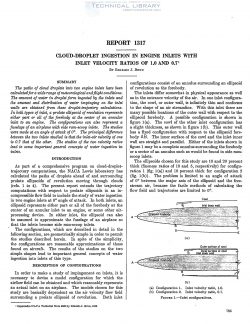naca-report-1317
- Version
- 193 Downloads
- 2.37 MB File Size
- 1 File Count
- November 2, 2016 Create Date
- November 2, 2016 Last Updated
National Advisory Committee for Aeronautics, Report - Cloud Droplet Ingestion in Engine Inlets with Inlet Velocity Ratios of 1.0 and 0.7

The paths of cloud droplets into two engine inlets have been
calculated for a wide range of meteorological and flight conditions.
The amount of water in droplet form ingested by the inlets and
the amount and distribution of water impinging on the inlet
walls are obtained from these droplet-trajectory calculations.
In both types of inlet, a prolate ellipsoid of revolution represents
either part or all of the forebody at the center of an annular
inlet to an engine. The configurations can also represent a
fuselage of an airplane with side ram-scoop inlets. The studies
were made at an angle of attack of 0°. The principal difierence
between the two inlets studied is that the inlet-air velocity of one
is 0.7 that of the other. The studies of the two velocity ratios
lead to some important general concepts of water ingestion in
inlets.
As part of a comprehensive program on cloud-droplet-
trajectory computations, the NACA Lewis laboratory has
calculated the paths of droplets ahead of and surrounding
prolate ellipsoids of revolution moving through clouds
(refs. 1 to 4). The present report extends the trajectory
computations with respect to prolate ellipsoids in an in-
compressible flow field to include the study of water ingestion
in two engine inlets at 0° angle of attack. In both inlets, an
ellipsoid represents either part or all of the forebody at the
center of an annular inlet to an engine, or some other air—
processing device. In either inlet, the ellipsoid can also
be assumed to approximate the fuselage of an airplane so
that the inlets become side ram-scoop inlets.
The configurations, which are described in detail in the
following section, are geometrically simple in order to permit
the studies described herein. In spite of the simplicity,
the configurations are reasonable approximations of those
found on aircraft. The results of the studies on the two
simple shapes lead to important general concepts of water
ingestion into inlets of this type.
In order to make a study of impingement on inlets, it is
necessary to devise a model configuration for which the
airflow field can be obtained and which reasonably represents
an actual inlet on an airplane. The models chosen for this
study are basically dependent on the air velocity flow field
surrounding a prolate ellipsoid of revolution.
| File | Action |
|---|---|
| naca-report-1317 Cloud Droplet Ingestion in Engine Inlets with Inlet Velocity Ratios of 1.0 and 0.7.pdf | Download |

Comment On This Post